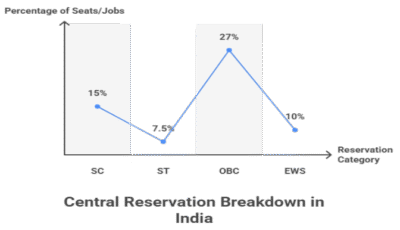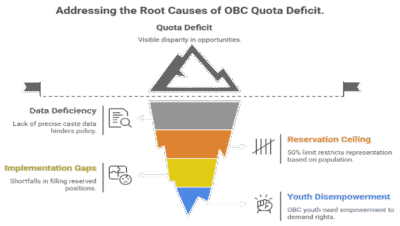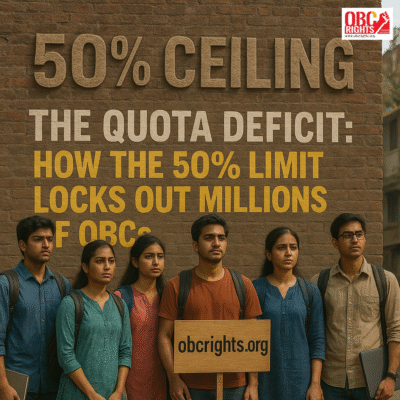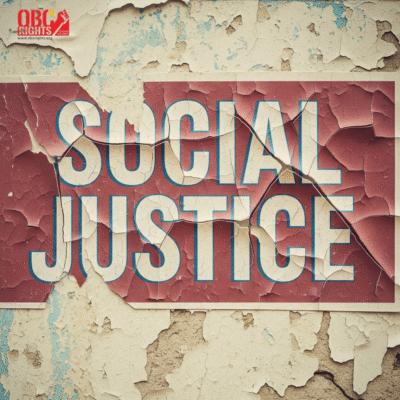Even in 2025, the OBC reservation in India faces a major hurdle. The 50% reservation ceiling in India has stood like an invisible wall—one that blocks millions of Other Backward Classes (OBCs) from accessing their rightful share of education, jobs, and power. What was once upheld as a “reasonable limit” has now become a structural barrier to social justice. Today, the quota deficit is not just a number—it is a denial of equality, opportunity, and dignity.
The Reality Behind the 27% Promise:
When the Mandal Commission recommendations were implemented in 1990, the 27% reservation for OBCs in central government jobs was seen as a historic step toward social equality. But the reality today is disappointing.
Official data shows that OBCs fill only 18–19% of the allocated quota in central government jobs. This leaves an 8–9% shortfall each year, representing thousands of missed opportunities. Reservation, which was meant to ensure fairness, has become only partially fulfilled – even after 75 years of Constitutional mandate.
What the 50% Reservation Limit Actually Means
The Supreme Court introduced the 50% ceiling in the Indra Sawhney vs. Union of India (1992) case. It was meant to ensure that at least half of all seats and jobs remain “open merit.” However, this ceiling is not part of the Constitution—it is a judicial rule.

Current central reservation breakdown:
- SC: 15%
- ST: 7.5%
- OBC: 27%
- Total = 49.5%
This means that even though OBCs make up more than half of India’s population, they cannot exceed 27% in reserved opportunities. At the same time, the 10% EWS quota for upper castes bypassed this ceiling, revealing an unfair and uneven enforcement of reservation policies. The sad part of it is that Tamil Nadu has only 3.5% advanced communities. Among them, only persons with Rs. 8 Lakhs and below are eligible for 10% EWS. Thus, approximately 2% of Advanced Communities may be eligible for a 10% reservation.
The 50% Ceiling: A Barrier to Equality
The 50% limit freezes social justice in place. When more than half of the population is limited to less than half the opportunities, the principle of equality is undermined.
While the ceiling was meant to protect “open merit,” its effect today is purely restrictive. Millions of OBC youth are denied fair access to education and jobs—not because they lack talent, but because of a cap that does not reflect demographic reality.
EWS and the Rewriting of Reservation
The Economically Weaker Sections (EWS) quota, introduced in 2019, broke the 50% limit for the first time. Yet it primarily benefits communities already dominant in education and employment. The selective flexibility—allowing some groups to exceed the ceiling while others remain restricted—exposes the hypocrisy in India’s reservation system.
Steps to Fix the OBC Quota Deficit
Fixing the quota deficit requires urgent action:
- Carry out a nationwide caste survey to gather precise data for informed policy decisions.
- Remove the 50% reservation ceiling to reflect population realities.
- Fill existing quota shortfalls in government jobs, the judiciary, and public institutions.
- Encourage youth mobilization, empowering OBC youth to demand rights, not favors.

The fight for OBC equality is not a demand for charity—it is a demand for justice rooted in the Constitution’s promise of equality. As long as the 50% ceiling remains, millions will remain locked out of opportunities they deserve. The time has come to break the ceiling, close the gap, and end the quota deficit once and for all.
Join the Fight for OBC Equality
The fight for OBC justice is not charity—it’s a constitutional right. Millions remain locked out because of outdated rules.
Breaking the ceiling and closing the quota deficit is long overdue. Join SFRBC/ OBCRIGHTS now and help demand fair representation, equal opportunity, and justice for millions of OBCs across India.



